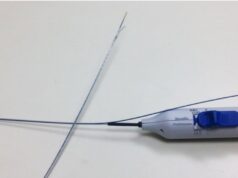
While the treatment of spider, reticular and varicose veins using sclerotherapy has been a standard practice for many years, tumescent enhanced sclerotherapy has been developed as an office-based technique that takes traditional sclerotherapy a step further by applying a tumescent anaesthetic solution with a peristaltic pump designed for the procedure. Inventor of the technique, Gregory Spitz (Aurora, Illinois, USA), explains in this article how the method was developed and the benefits it can offer to both patients and physicians.
In short, tumescent enhanced sclerotherapy (TES) provides immediate compression around the vein, thereby helping to maintain the sclerosing agent in the portion of the vein in which it was injected. In addition, the tumescent solution theoretically reduces the inflammation of surrounding tissues— caused by the sclerosing agent—by diluting any of the sclerosing solution that may inadvertently leak out of the vein.
Under pressure, the tumescent solution potentially increases the surface area that the injected sclerosant will be in contact with by displacing blood in the target vessel. Due to the immediate increased compression, the patient may require less post procedure compression. Moreover, evaluation has shown that this procedure has a short learning curve for the physician, and offers superior ablation of affected veins with fewer treatments.
Patient selection and preparation
Since 2006, TES has been employed in our clinic for the treatment of spider, reticular and varicose veins. When determining the feasibility of using TES as a primary mode of treatment, patient selection and evaluation are incredibly important. This means that an appropriate background check on the patient’s medical history and physical examination should be performed; this is because patients taking aspirin, antiplatelet drugs or antithrombotic agents need to be treated appropriately, as with standard sclerotherapy.
Those patients selected for the TES procedure are placed in a supine or prone position on the examination table, and it should be noted that a motorised table is a very advantageous tool for this procedure. Standard skin preparation is conducted as part of the process, while the positioning of the leg is determined by the location of the veins to be treated.
Explaining the technique
First and foremost, the office-based procedure does not require the patient to be anaesthetised or sedated prior to TES. The patient’s legs are first marked with an indelible ink marker; spider veins usually do not need to be outlined, while varicose or reticular veins are marked by a simple outline. Equipment required for the procedure is very simple, and we use the sclerotherapy solution polidocanol, ranging from 0.25—1%, and ICC syringes with half-inch 30- and 32-gauge needles. However, practitioners can use the needles and solution that they normally use for sclerotherapy.
In addition, we utilise a kit that includes a 31-gauge half-inch needle, two 25-gauge 1.5inch needles, gauze pads and sterile tubing for the portable peristaltic infiltration pump. The tubing is unique in that it splits into a Y configuration, allowing two different needles to be used for the tumescent infiltration to be more efficient. In addition, two additional needles, 18- and 20-gauge, are included if drainage of previously treated sites is required.
With the patient prone or supine (depending on the location of the treated veins), sclerotherapy with the 31- and 32-gauge needles commences. The choice of solution for the surgeon is usually based on personal preference, although a more concentrated solution can be used on larger vessels. We utilize two different colour needle hubs to avoid confusion as to which solution is in which syringe, as well as treating larger veins (any that will have a flashback of blood) with the more concentrated solution 0.596—1%. Alternatively, all others are treated with the smaller 32-gauge needles and syringes, loaded with a less concentrated solution 0.25%.
Furthermore, we tend to approach an area as a cluster or grouping of veins to be treated. After an area is sclerosed, the next step is tumescent infiltration. For this, a standard tumescent solution consisting of 250ml of 0.9 normal saline, mixed with 10ml of 2% plain lidocaine, 0.25mg of 1:1000 epinephrine and 2.5mEq of sodium bicarbonate, is used.
Our peristaltic pump has a convenient foot pedal that instils the solution from the 25-gauge needles (two of them) attached to the Y tubing. When the foot pedal is depressed the pump activates and when foot pressure is released the pump stops, which allows maximum control of the infiltration. Also, there is a manual clamp on each arm of the Y infusion tubing, so that one or two needles can be used at the same time.
We start with a wheal with one needle and then use both needles to tumesce the treated areas. Then, we bend the 25-gauge needles by 90 degrees prior to infiltration, which enables us to have better control. The endpoint of tumescent infiltration is a “peau d’ orange” (orange peel) effect, and infiltration is complete when a field of 1—2cm forms, in a field block fashion, around the area where sclerotherapy was performed.
The first thing we noticed, in terms of the effects of the TES procedure, was a decrease in post-inflammatory hyperpigmentation, which has been the plague of sclerotherapy since its inception. Further to this, as the treating physician gets more adept at the technique, the instillation of tumescent solution around the area of sclerotherapy occurs almost simultaneously.
Advantages of the procedure
In terms of benefits, especially for patients, there are several advantages to the TES approach to sclerotherapy. Firstly, this procedure allows for immediate sustained compression, while the sclerosant used can also be isolated in the intended vein. TES also facilitates the dilution of any extravasated sclerosant, as well the separation of skin from the treated vein—this allows for a less inflammatory effect to be had on the skin.
Other benefits of the procedure include the fact that it is well tolerated by patients, a crucial factor. For physicians, it is easy to learn and offers reproducible results, delivering advantages in terms of both time- and cost-efficiency. Finally, the use TES achieves the desired effect with the use of less concentrated solutions which, in turn, could reduce the number of complications associated with sclerotherapy.
Growing the profile of TES
Following the inception of the procedure, hundreds of surgeons have been trained in this technique, while other tumescent-assisted procedures have subsequently been developed. Kurosh Parsi (University of New South Wales, Sydney, Australia) is one of several enthusiasts who have also used the procedure, along with Paul Thibault (Broadmeadow, Australia) and Attilio Cavezzi (San Benedetto del Tronto, Italy).
Speaking about the TES procedure, Parsi has said: “It is time we all acknowledge that there is a strong body of science behind the procedure of sclerotherapy and the days of treating sclerotherapy as a simple ‘injection treatment’ are well and truly over. It has been conclusively demonstrated that blood deactivates the sclerosants. TES ensures an empty vein is obtained at the time of treatment, preventing deactivation by blood and providing internal compression.
“This is particularly important, given the findings of Partsch, Mosti and Uh’ that compression stockings do not compress the superficial veins. By providing internal compression, TES minimises our dependence on external compression provided by compression stockings. The empty vein state ensures exposure of the sclerosant to the target endothelium limiting unwanted interference by blood cells. In my opinion, the intravascular blood is the ultimate enemy when performing sclerotherapy and should be eliminated at all costs.
“The TES procedure pioneered by Greg Spitz and taken up by hundreds of phlebologists is an excellent method to achieve an empty vein state and ultimately good treatment outcomes. Classical complications such as pigmentation and matting can be significantly minimised using this technique. I recommend to all phlebologists to include this procedure in their armamentarium of venous interventions.”
In summary, the TES procedure provides us with a simple, cost-effective way of performing potentially more effective sclerotherapy with a short learning curve, no known significant complications and good cosmetic results in potentially fewer treatments. This can be beneficial for both patients and physicians, and will continue to grow in popularity around the world.
Gregory Spitz is a board certified general surgeon that has been treating vein disease for over 25 years. He has patented several medical devices including the TriVex System and the Tumescent Inversion Catheter. He has travelled all over the world lecturing and training doctors in the management of vein disease. He is the founder of AmeriVein Systems, based in the Chicago, Illinois, USA.












